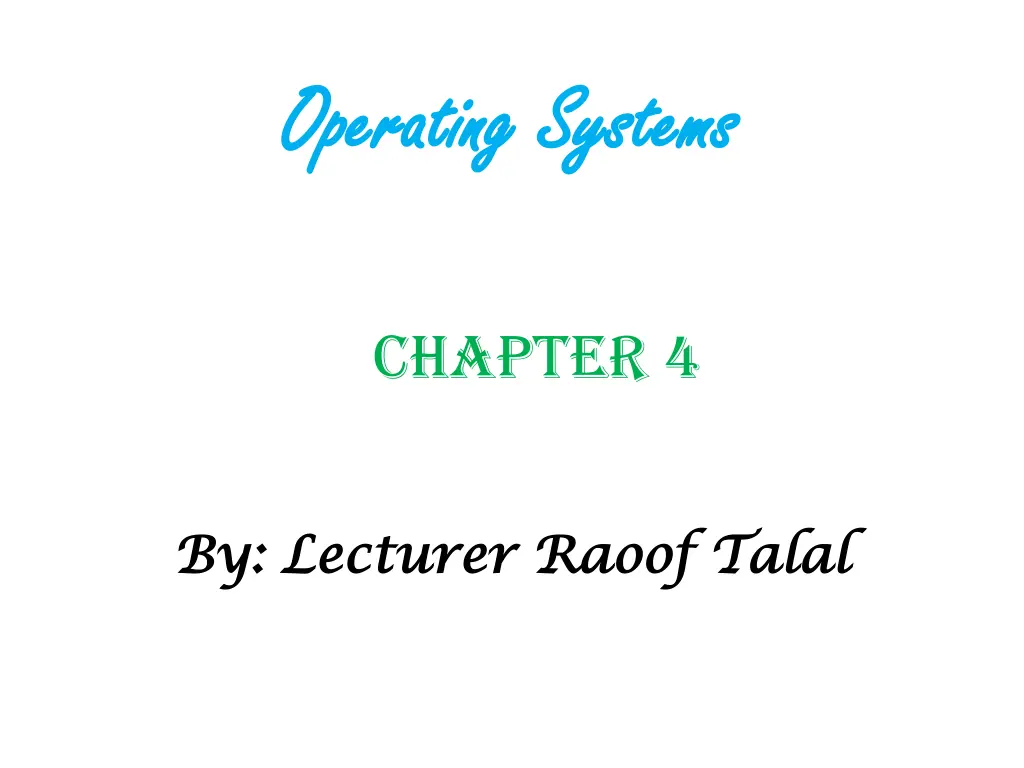
Advanced Concepts in Disk Allocation and Free-Space Management
Explore indexed allocation and free-space management in operating systems, solving fragmentation issues and optimizing disk space allocation. Learn about index blocks, pointers, free-space lists, and bit vector implementation for efficient storage management.
Download Presentation

Please find below an Image/Link to download the presentation.
The content on the website is provided AS IS for your information and personal use only. It may not be sold, licensed, or shared on other websites without obtaining consent from the author. If you encounter any issues during the download, it is possible that the publisher has removed the file from their server.
You are allowed to download the files provided on this website for personal or commercial use, subject to the condition that they are used lawfully. All files are the property of their respective owners.
The content on the website is provided AS IS for your information and personal use only. It may not be sold, licensed, or shared on other websites without obtaining consent from the author.
E N D
Presentation Transcript
Operating Systems Operating Systems Chapter 4 By By: Lecturer : Lecturer Raoof Raoof Talal Talal
4.3.3 Indexed Allocation Linked allocation solves the external-fragmentation and size-declaration problems of contiguous allocation. However, in the absence of a FAT, linked allocation cannot support efficient direct access, since the pointers to the blocks are scattered with the blocks themselves all over the disk and must be retrieved in order.
Indexed allocation solves this problem by bringing all the pointers together into one location: the index block. Each file has its own index block, which is an array of disk-block addresses. The ith entry in the index block points to the ith block of the file. The directory contains the address of the index block.
When the file is created, all pointers in the index block are set to nil. When the ith block is first written, a block is obtained from the free-space manager, and its address is put in the ith index- block entry.
4.4 Free-Space Management Since disk space is limited, we need to reuse the space from deleted files for new files, if possible. To keep track of free disk space, the system maintains a free-space list. The free-space list records all free disk blocks those not allocated to some file or directory.
To create a file, we search the free-space list for the required amount of space and allocate that space to the new file. This space is then removed from the free-space list. When a file is deleted, its disk space is added to the free-space list. The free-space list, despite its name, might not be implemented as a list, as we discuss next.
4.4.1 Bit Vector Frequently, the free-space list is implemented as a bit map or bit vector. Each block is represented by 1 bit. If the block is free, the bit is 1; if the block is allocated, the bit is 0.
For example, consider a disk where blocks 2, 3, 4, 5, 8, 9, 10, 11, 12, 13, 17, 18, 25, 26, and 27 are free and the rest of the blocks are allocated. The free-space bit map would be 001111001111110001100000011100000 ... The main advantage of this approach is its relative simplicity and its efficiency in finding the first free block or n consecutive free blocks on the disk, indeed, many computers supply bit-manipulation instructions that can be used effectively for that purpose.
Example: Assume the following are free. Rest are allocated: 2,3,4,5,9,10,13
4.4.2 Linked List Another approach to free-space management is to link together all the free disk blocks, keeping a pointer to the first free block in a special location on the disk and caching it in memory. This first block contains a pointer to the next free disk block, and so on. In our earlier example, we would keep a pointer to block 2 as the first free block. Block 2 would contain a pointer to block 3, which would point to block 4, which would point to block 5, which would point to block 8, and so on . However; this scheme is not efficient; to traverse the list, we must read each block, which requires substantial I/O time.
4.4.3 Grouping A modification of the free-list approach is to store the addresses of n free blocks in the first free block. The first n-1 of these blocks are actually free. The last block contains the addresses of other n free blocks, and so on. The addresses of a large number of free blocks can now be found quickly, unlike the situation when the standard linked-list approach is used.
4.4.4 Counting Another approach is to take advantage of the fact that, generally, several contiguous blocks may be allocated or freed simultaneously, particularly when space is allocated with the contiguous- allocation algorithm or through clustering. Thus, rather than keeping a list of n free disk addresses, we can keep the address of the first free block and the number n of free contiguous blocks that follow the first block. Each entry in the free-space list then consists of a disk address and a count.
4.5 Recovery 4.5.1 Consistency Checking Some directory information is kept in main memory (or cache) to speed up access. The directory information in main memory is generally more up to date than is the corresponding information on the disk, because cached directory information is not necessarily written to disk as soon as the update takes place.
Consider, then, the possible effect of a computer crash. Cache and buffer contents, as well as I/O operations in progress, can be lost, and with them any changes in the directories of opened files. Such an event can leave the file system in an inconsistent state: The actual state of some files is not as described in the directory structure. Frequently, a special program is run at reboot time to check for and correct disk inconsistencies.
4.5.2 Backup and Restore Magnetic disks sometimes fail, and care must be taken to ensure that the data lost in such a failure are not lost forever. To this end, system programs can be used to back up data from disk to another storage device, such as a floppy disk, magnetic tape, optical disk, or other hard disk. Recovery from the loss of an individual file, or of an entire disk, may then be a matter of restoring the data from backup.






















